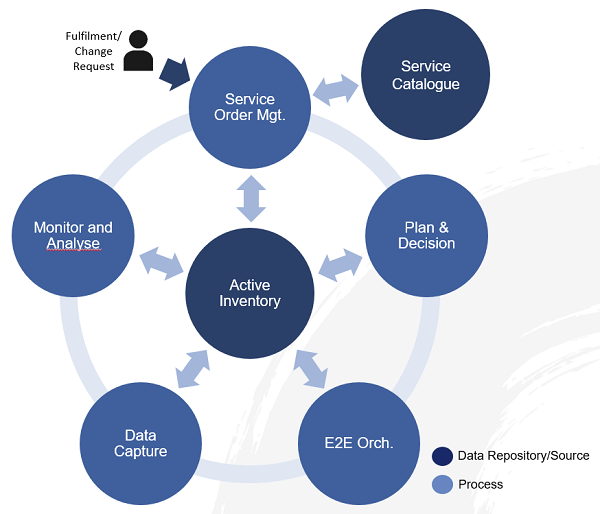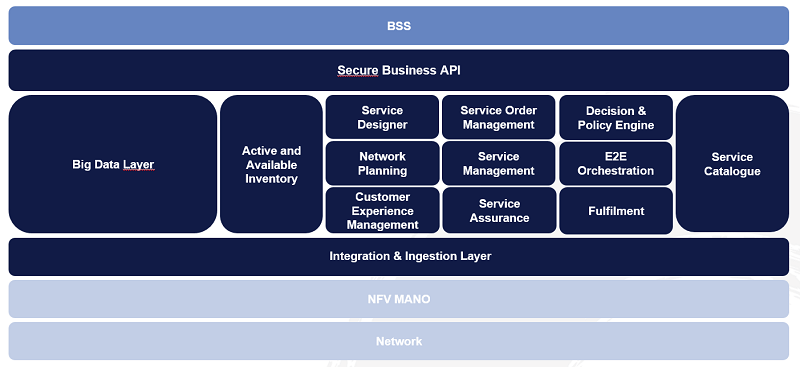 Communication Service Providers (CSPs) are increasingly trying to introduce automation into the operation of the network, partly to improve efficiency. However, as the complexity of the network technology continues to increase, the ability of operators to manage their network efficiently will reduce without the use of automation and AI.
Communication Service Providers (CSPs) are increasingly trying to introduce automation into the operation of the network, partly to improve efficiency. However, as the complexity of the network technology continues to increase, the ability of operators to manage their network efficiently will reduce without the use of automation and AI.
Despite the desire to deploy automation and in many cases having invested millions of pounds, attempts at introducing automation have, to date, had only limited success. This has generally been a result of relying too much on individual technology solutions, along with poor or inadequate architecture, design and implementation governance, due to inadequate skills within the CSPs.
In addition, a fundamental lack of understanding about the criticality of data in automated systems and for AI means that insufficient focus and attention is applied to this key domain. This leads to insufficient data being made available to the technologies deployed – and ultimately poor outcomes.
Goals
The goal for all CSPs is to:
- Drive incremental revenue through the introduction of new innovative services
- Improve customer experience
- Increase efficiency in the operation of the network to reduce costs and improve margins
Problems and challenges
There are a number of problems and challenges that are at the heart of the current lack of success in the execution of automation within CSPs:
- The criticality of identifying the business outcomes to be achieved and the definition of KPIs to measure success of any investment in change is not understood. This results in most attempts at automation failing to actually deliver the potential business value.
- The importance of delivering holistic solutions that deliver the business value, is often lost in the outsourced (siloed) and technology centric deployment models favoured by most CSPs.
- A lack of understanding by the existing staff of the criticality for automation and how it should be developed and implemented.
- Insufficient appreciation of the importance of data as an enabler of automation. Traditional data sets, held in their closed, bespoke and siloed applications, are insufficient in their current form to support automation.
- Linked to the above is the necessity for a set of operational processes that ensure that an appropriate data quality is created and maintained.
Whilst the first two problems can be addressed relatively easily, through the adoption of best practice approaches and processes, the last three challenges are potentially more significant issues. So, we will focus on these.
Addressing the challenges
Understanding the criticality of automation
There is often a degree of healthy scepticism among network operations staff with regards to the true value and ability to deliver automation in network operations. Given that no automated process will succeed without the full support and contribution of the operations staff, it is critical that this issue is overcome – and that staff see automation as an opportunity and not a threat.
We recommend that an active approach is taken to gaining the buy-in from these critical resources, based around how the technology and processes can improve their day to day experience.
The importance of data
These days most people understand the importance of data for reporting and analytics. However, the use of data by automated processes is often less appreciated and the necessity for complete and accurate data not understood. This can only be addressed through education on how automation operates.
An interesting fact is that most of the data exists today (part of the reason the data issue is underappreciated), however, it is usually siloed and not linkable between silos as a result of historic manual processes.
The data required to perform network related automation can essentially be divided into four areas:
- The criticality of identifying the business outcomes to be achieved and the definition of KPIs to measure success of any investment in change is not understood. This results in most attempts at automation failing to actually deliver the potential business value.
- The importance of delivering holistic solutions that deliver the business value, is often lost in the outsourced (siloed) and technology centric deployment models favoured by most CSPs.
- A lack of understanding by the existing staff of the criticality for automation and how it should be developed and implemented.
- Insufficient appreciation of the importance of data as an enabler of automation. Traditional data sets, held in their closed, bespoke and siloed applications, are insufficient in their current form to support automation.
- Linked to the above is the necessity for a set of operational processes that ensure that an appropriate data quality is created and maintained.
In order to form the basis of network operations, all the above data must be able to be correlated with each other. This is something that will naturally occur if a holistic approach is taken to the overall data architecture and design.
The need for strong operational processes
Too often the deployment of automation is seen as a technology delivery – rather than combining technology with business process and change. It is essential that the business systems and human resources adopt the right approaches and processes to ensure that the technology can deliver the expected business value.
Our approach
As illustrated in the diagram below, the key to success is the creation of a digital representation of the network and services (active inventory and the service catalogue) and a set of operational processes and tools to manage the data flows around the business and systems.
The service catalogue provides the digital blueprints used to deploy and fulfil services, whilst the active inventory enables the real-time digital representation of the current network and its status.

Figure 1 - Network Operating Model
The operations process
As illustrated in the diagram above, the service order management (SOM) system serves as the single entry point for all changes in the network, whether manually or automatically initiated. It has access to the details of the services supported by the underlying network technology, that are contained in the service catalogue, which contains a blueprint for how each service is to be implemented and in a format that can be consumed by all other systems.
Before any change is made, the plan and decision process determines if and how the change should be applied, including whether the change is manual of automated. If the change is to be manual, the service order can be passed to the system that will manage the manual process.
Irrespective of whether a change is manual or automated (via the E2E Orchestrator), prior to deployment, all changes are tracked in the active inventory to create a record of those planned changes, including the addition of any appropriate meta data. Following successful deployment, the data capture process adds the dynamically discovered details to the planned record to create a completed record and changes the status to indicate the component or connection is in ‘production’.
During operation, data captured from the network in the form of fault notifications, performance data, control and user plane data is, processed (using the data held in the Active Inventory for reference) and stored. This processing enables real-time, automated monitoring, analysis and actioning and where change is needed e.g. to remediate a fault, is able to automatically raise tickets and change order requests via the SOM.
Based on the above, it is clear that the service catalogue and active inventory are the most critical data sets that enable automated deployment, monitoring and remediation.
Recommendations
We recommend an approach which is based on addressing the following key areas:
- In order for automated service deployment to be achieved, it is critical that the product catalogue, made available to customers to describe what they can purchase, is tightly coupled/mapped to the service catalogue, used to deploy the purchased services. Typically, this has not been the case and is an underlying cause for the lack of automation today in CSPs. Whilst technically simple to implement, organisational structures often hamper attempts to implement automation e.g. the separation of BSS (Product Catalogue owners) and OSS (Service Catalogue consumers and owners).
- Develop the active inventory, appropriate integrations and business processes that ensure that the planning data is added and that the identifiers added at plan time, are the same as those added at deploy time, to ensure that inventory data, fault, performance data etc. can be correlated with active inventory data.
- In order to ensure that the network data is accessible to all users and systems, we strongly recommend a solution that captures, correlates, processes and stores this data – prior to making it available to other applications such as planning, service assurance and management, which historically consume the data and then make it hard or impossible for external systems and users to access.
The diagram below illustrates a reference architecture for a next generation OSS that can enable the automation of; deployment, monitoring, fault remediation and re-scaling.

Figure 2 – OSS Reference Architecture
Measuring and understanding success It is critical to be able to measure the benefit gained from any automation initiative. We therefore recommend that a set of business outcomes and a set of a key performance indicators (KPIs) are identified at the start of the process. If these are not in place, identifying success will be impossible. We recommend using the TM Forum Metrics Definitions as a great source of suitable KPIs.
Summary
At NTT DATA, we understand the criticality of successfully deploying automation into the management of networks, to enable the continued efficient operations of an environment of constantly growing in complexity, brought about by the growth in the ‘softwareisation’ of network technology and the introduction of new network standards such as 5G.
If you would like further information on our how to successfully architect, design and deploy network automation, please contact Ian Middleton of our Network Practice at ian.middleton@nttdata.com.